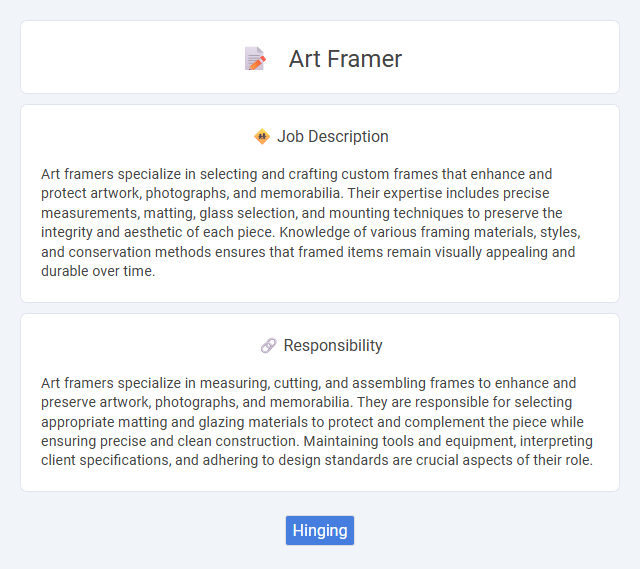
Art framers specialize in selecting and crafting custom frames that enhance and protect artwork, photographs, and memorabilia. Their expertise includes precise measurements, matting, glass selection, and mounting techniques to preserve the integrity and aesthetic of each piece. Knowledge of various framing materials, styles, and conservation methods ensures that framed items remain visually appealing and durable over time.
Individuals with strong attention to detail and patience are likely to thrive as art framers, as the job requires precise measurements and careful handling of delicate materials. Those who enjoy working with their hands and have a steady, coordinated approach may find this role more suitable compared to individuals who prefer fast-paced or highly social environments. People with limited dexterity or low tolerance for repetitive tasks might find the demands of art framing challenging and less suited to their capabilities.
Qualification
Art framers require strong knowledge of various framing materials, precise measuring skills, and expertise in matting and glazing to protect and enhance artwork. Proficiency with cutting tools, attention to detail, and a keen eye for color coordination are essential qualifications. Experience in customer service and understanding art styles contribute to delivering tailored framing solutions that preserve and complement artistic pieces.
Responsibility
Art framers specialize in measuring, cutting, and assembling frames to enhance and preserve artwork, photographs, and memorabilia. They are responsible for selecting appropriate matting and glazing materials to protect and complement the piece while ensuring precise and clean construction. Maintaining tools and equipment, interpreting client specifications, and adhering to design standards are crucial aspects of their role.
Benefit
An art framer likely enjoys the benefit of transforming and preserving valuable artworks, which can provide a strong sense of accomplishment and creativity. The job may offer stable demand due to ongoing interest in art presentation and conservation, potentially leading to consistent income. Skilled framing professionals often have opportunities to build relationships with artists and galleries, enhancing their professional network and career growth.
Challenge
Art framing likely presents challenges such as maintaining precision while cutting materials and assembling frames to protect and highlight artwork effectively. The job probably requires a keen eye for detail to match frame styles with different art pieces, balancing aesthetics and preservation needs. Handling fragile materials and managing custom orders may also pose frequent difficulties in this role.
Career Advancement
Art framers enhance their skills through mastering precision cutting and design techniques, essential for mounting and preserving artwork. Specializing in custom framing and materials knowledge positions professionals for leadership roles in galleries or bespoke framing studios. Advancing in the art framing industry often involves developing client relationship skills and expanding expertise in contemporary art trends to manage larger projects or open independent studios.
Key Terms
Hinging
Hinging in art framing involves securely attaching artworks to mounting boards or mats, ensuring preservation and stability without damaging the piece. Techniques such as Japanese paper hinges and archival tape are commonly used to allow for easy removal and prevent adhesive residue. Proper hinging maintains the artwork's integrity while providing optimal support for display and storage.
 kuljobs.com
kuljobs.com